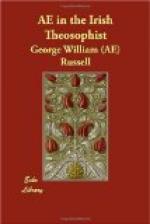The meaning of this story, with all its quaint imagery, is not difficult. It is an allegory describing the loss of the third eye. The cave is the body. The fish is a phallic symbol, and the cooking of it refers to the fall of the early ethereal races into generation and eventually into gross sensuality. The synthetic action of the highest spiritual faculty, in which all the powers of man are present, is shown by the manner in which everything in the cave is dragged up to the giant’s head. When Finn destroys the eye by plunging into it a bar of red-hot iron, it simply means that the currents started in the generative organs rose up through the spinal cord to the brain, and, acting upon the pineal gland, atrophied or petrified it. The principle of desire is literally the spirit of the metal iron, and a clairvoyent could see these red fires mounting up by the way of the spinal canal to the brain and there smothering any higher feelings. The escape of Finn under the fleece of the ram means that, having destroyed the spiritual eye, he could only use the organ of psychic clairvoyance, which is symbolized here, as in the mysticism of other countries, by the ram.
This symbolism, so grotesque and unmeaning today, was once perfectly lucid and was justified in its application. A clairvoyant could see in the aura of man around every centre the glow, colour and form which gave rise to the antique symbol. One of the Gods is described as “surrounded by a rainbow and fiery dews.” Cuchullin, whose hair, dark (blue?) close to the skin, red beyond, and ending in brilliant gold, makes Professor Rhys elaborate him into a solar myth, is an adept who has assimilated the substance of the three worlds, the physical, the psychic and the heavenworld; therefore his hair (aura) shows the three colours. He has the sevenfold vision also, indicated by the seven pupils in his eyes. Volumes of unutterably dreary research, full of a false learning, have been written about these legends. Some try to show that much of the imagery arose from observation of the heavenly bodies and the procession of the seasons. But who of the old bards would have described nature other than as she is? The morning notes of Celtic song breathe the freshness of spring and are full of joy in nature. They could communicate this much better than most of their critics could do. It is only the world within which could not be rendered otherwise than by myth and symbol. We do not need scholarship so much as a little imagination to interpret them. We




